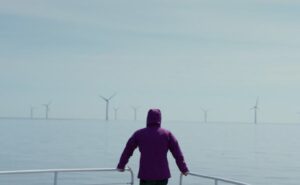GE has been quietly working on a radical new wind turbine design for a good two years, and now that the company is finally ready to let the cat out of the bag, we can see why it’s been playing it close to the vest. The new design looks like somebody snuck up behind a standard wind turbine and slapped a 20,000 pound clown nose on its face. It’s funny-looking all right, but the new turbine — which some have dubbed the “big-nosed wind turbine” — is up and running at a test site in California and we’re dying to see what the data show.
To gild the lily, GE has parked the new big-nosed wind turbine on top of its new Space Frame wind turbine tower, so let’s take a look at both.
The New Big Nosed Wind Turbine From GE
We have another four months to die because that’s how long the data collection phase for the prototype is going to take, but in the meantime, GE has been forthcoming with an R&D timeline for the new big-nosed wind turbine.
The new wind turbine actually has a name and it’s not “big-nose.” It’s ecoROTR. The idea is to put a dome over the middle of the turbine, where the blades would normally meet. In theory, that lets you milk more energy out of the same amount of wind.
Here’s how GE stacks up the comparison with standard wind turbines:
When wind hits the center of the wind turbine where the blades are attached, it’s wasted. That’s because the blades are basically levers and the same wind generates more force further from the hub.
So far, so good on the test phase. The design started with a styrofoam ball, some toothpicks, and a thorough round of testing at GE’s wind tunnel lab in New York.
The tests indicated the potential for a 3% improvement in performance, which doesn’t seem all that spectacular on an individual basis. However, GE points out that when you tote up the savings from a modern wind farm — and today’s wind farms tend to be gigantic — the numbers add up to a tasty pile.
Anyways, that was enough to justify a small-scale prototype for testing, and those results were satisfying enough for the development of the full-scale dome.
GE is certainly not horsing around with this phase of the testing process. The dome measures 60 feet in diameter and does indeed weigh 20,000 pounds. GE selected a 1.7 megawatt turbine, which is not the most powerful in its lineup (that would be the 3.2 designed for high-speed winds), but it is powerful enough to make the point.
Size Matters
According to GE’s wind turbine product information, the blades for its 1.7–100 megawatt model turbine clock in at 48.7 meters, or almost 160 feet long. Blades for the 1.7–103 model are slightly longer, but you get the point — at half the length of a football field, turbine blades are a bear to transport and install.
In hard-to-access locations, that means you could have to cut new access roads and make other infrastructure adjustments, all of which adds to the cost of a new wind farm and undercuts the advantage of wind over other power sources.
Even without the adjustments, wind turbine (and tower) transportation often involves local police escorts and other manpower for oversized loads, which adds to the final costs.
So, if the full-scale prototype pans out, keep your eyes peeled for the next iteration from GE. We’re guessing that it will be a component-based dome that can be assembled on site, with shorter blades that will be attached to the perimeter, and the whole thing will be designed for easy transportation — possibly in street-legal batches that don’t require escorts or other special considerations.
That brings us to the Space Frame wind turbine tower prototype. Last year, GE gave CleanTechnica a sneak peek at the new tower (yes, we got to climb to the top), which is base on the same idea: relatively small components that can be transported via existing infrastructure and assembled on site.
The whole thing looks like something you could put together from an Erector set, which is the point. If you take a look at that ecoROTR photo up above, you can see that the dome also lends itself to modular construction, with the frame covered by a lightweight cladding.
Here’s our view of the Space Frame tower from the inside, on the ground looking up:

The white stuff is a polyvinyl cladding that gives the Space Frame a couple of potential advantages over steel tube towers, aside from minimizing the use of steel. Notice, for one thing, that the access ladder is on the inside, which means that if you have to go up the ladder in bad weather, no worries (we went up the tower in a bucket, btw — but we did come down by the ladder).
The cladding also discourages birds from nesting in the tower, which could lead to many unfortunate accidents. GE is also figuring that the cladding makes the Space Frame look a little more like conventional wind turbine towers, which could come into play where aesthetics call for a more conventional look.
Space Frame + ecoROTR could be “the perfect couple” according to GE (add in this and you’ll get a threesome), so we’ll be sure to check back in a few months and see what the numbers show.
Source: CleanTechnica. Reproduced with permission.









